Class of 1969 reminisces about OHIO experiences 50 years later
As members of Ohio University’s Class of 2019 prepare to leave their campus community in pursuit of career opportunities, travel plans and other aspirations, some of their fellow Bobcats are celebrating 50 years since they made those same leaps.
This year marks a significant milestone for the Class of 1969 and presents an opportunity for OHIO’s Golden Bobcats to reflect upon the years they spent in Athens — though 50 years ago, campus was a much different place.
The late 1960s were marked by protests and unrest on college campuses across the country as the Vietnam War escalated. Athens was no different. Throughout the 1968-69 academic year, OHIO students protested against the war as well as the growing presence of military forces on campus, often staging their rallies outside of Templeton-Blackburn Alumni Memorial Auditorium and around the historic Soldiers and Sailors Monument on College Green. It was less than a year after the Class of 1969 graduated that Ohio University closed in the midst of increasingly violent clashes between students and National Guardsmen following the fatal shootings at Kent State.
The 1968-69 academic year also marked a period of significant transition on the Athens Campus, both physically and in leadership.
The year started with the opening of OHIO’s Convocation Center (which hosted its first Commencement, for the Class of 1969, on June 8, 1969) and the September announcement that OHIO’s 15th president, Vernon R. Alden, would be resigning at the end of the academic year.
The year ended with the opening of Alden Library and an April 12, 1969, groundbreaking for one of the largest transformations on the Athens campus to date, the re-routing of the Hocking River. (Check out this Ohio Today article highlighting the mammoth undertaking that saved the Athens campus from repeated incidents of flooding.) And the Class of 1969 departed OHIO as construction continued on the South Green residence halls and Morton Hall.
Ohio Today news caught up with some of OHIO’s Golden Bobcats to get personal insights into individual experiences from the Class of 1969. Here are excerpts from some of their stories:
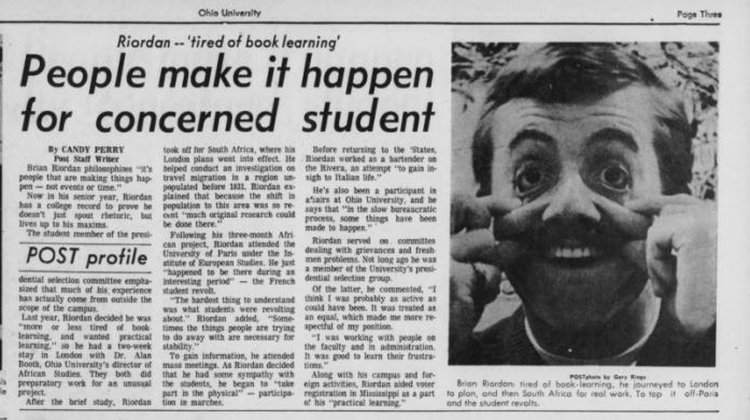
Brian Riordan, AB ’69, is featured in this April 29, 1969 article in The Post. Photo courtesy Mahn Center for Archives and Special Collections
Brian Riordan, AB ’69, African History
As an OHIO undergraduate from Massachusetts, Brian Riordan participated in the OHIO Fellows, a nontraditional scholars program; the Omicron Delta Kappa national leadership honor society; and accompanied Dr. Alan Booth, OHIO’s then-director of African Studies, on a Fulbright Foundation-funded research trip to South Africa. He currently lives in Montreal where he serves as a judge on the Superior Court of Québec.
What brought you to Ohio University?
Dr. Alden was called out from Harvard Business School where he was working, and when he got to OHIO, he wanted to try to diversify the student population. He had a very good contact with the Massachusetts Golf Association who had just started up a scholarship foundation for caddies. I was a caddy in Massachusetts at the time, and I had applied for the scholarship. I had already been accepted to go to college in Massachusetts and I wasn’t very happy about that. I wanted to see other parts of the world. When I went to interview for the (scholarship), they asked me if I’d like to go to Ohio University, and I said, “Well, good football team,” and they said “No, that’s Ohio State. This is a different place, but it’s better.” I was 17 at the time and I said, “Let’s do it.” So I and four others from Massachusetts, including Ro Fallon who became my best friend, came down. I didn’t know them, but Ro and I are still close friends. I see him regularly. And I came to Ohio University for that reason.
While you were in Athens, what clubs were you involved in?
I was on the committee to find a new president, so that’s probably my main extracurricular. That and the Union Pub (laughs). I was a dormitory counselor during my fourth year because I spent my third year in France. When I came back, I was a dorm counselor in Gamertsfelder. I lived in James Hall my first and second year.
What made you want to study African history at Ohio University?

Brian Riordan, AB ’69, lives in Montreal where he serves as a judge on the Superior Court of Québec.
There was this fantastic trip to South Africa that Dr. Alan Booth had financing for. He could only pay for students who were majors in African history, so I changed my major. I’m a very practical guy, you know. Then the next year, that was in the summer of ’67, I had already applied to study at the University of Paris for the year, so on my way to Paris, I went to South Africa.
What was campus like in the late 1960s?
A lot of people protested. I left in the spring of 1967 to go to South Africa and France. I came back in the fall of ’68, so I was away for 15 months. The world entirely changed in between those times. When I left, the guys had short hair and the girls wore nice sweaters and people were having a beer or two. When I came back, everybody was smoking marijuana and other things. Guys had long hair and beards. Some people I couldn’t even recognize anymore. It was a whole different world. If the streets hadn’t looked the same, I wouldn’t believe I was in the same place. It changed so much. Athens was really in the middle of the anti-war protests. Lyndon Johnson came to speak and there were demonstrations against him. We did an all-night vigil one time; it was wild. It was incredible. We really thought the world was going in the right direction at the time and that if it would continue going in that direction it would be a much better place. I guess we were wrong, looking back in hindsight, but at the time we thought we corrected all the problems. …
In the late ’60s, everybody was sort of discovering themselves and discovering the world. (Listen to this Ohio Today radio podcast to hear from three alumnae who were change agents at OHIO in the late ’60s.) Although there was a lot of demonstrations, and some negativism, I think there was an overall feeling that we were a family. The nonacademic employees had a big strike, and there was great support among the students for them. By the time we were choosing the successor to Vernon Alden, there was a representative of the nonacademic employees on the committee. The University was open to trying new things while at the same time maintaining a level of academic excellence that really served me well. It was an exciting time I must say. I was sorry to graduate.
What was post-graduation life like?
I was dodging the draft. So, thanks to Les Rollins, the man from the OHIO Fellows Program, he helped me find a job in North Carolina teaching because that was a deferment. I spent a year there. I was admitted to law school, but if I went to law school, I would have been drafted. After a year teaching, I figured I better do something else, so I applied to McGill University in Montreal to get a degree in economics, and I moved to Canada. After my master’s degree, I worked in Tunisia for a while and then ended up in Hartford, Connecticut for a couple of years. I finally did go to law school at McGill and have working (mostly in French) in Montreal ever since.
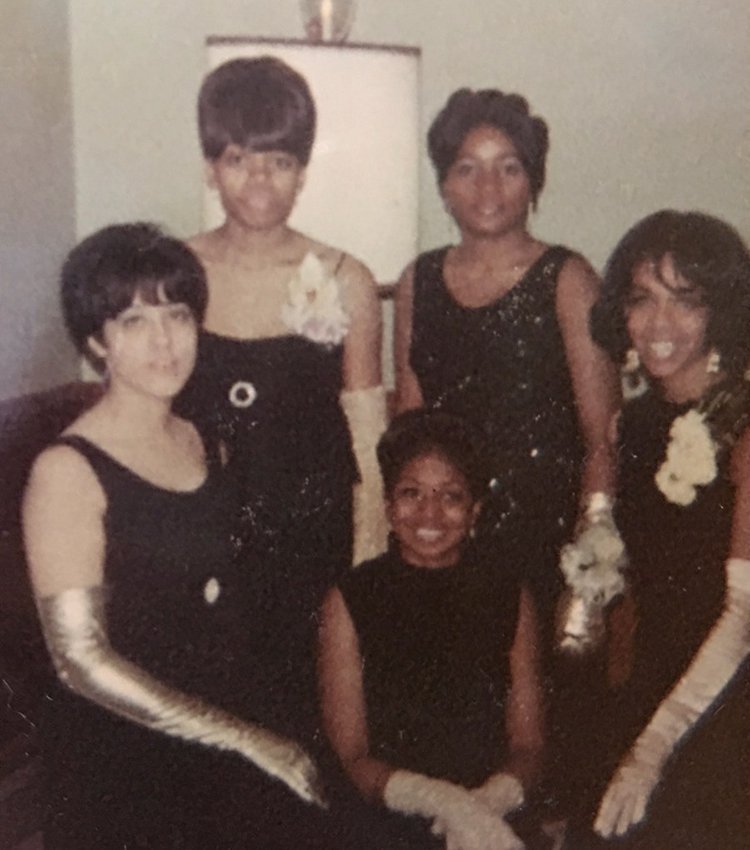
Maurine McDaniel, BFA ’69, MFA ’75, is pictured with some of her Alpha Kappa Alpha sorority sisters.
Maurine McDaniel, BFA ’69, MFA ’75, Studio Art and Ceramics
While at Ohio University, Maurine McDaniel was an active member of Alpha Kappa Alpha and represented her sorority on the 1968 Homecoming Court. Today, McDaniel is an associate professor in Spelman College’s Department of Art and Visual Culture in Atlanta, Georgia.
What brought you to Ohio University?
Well, I’m originally from a city in West Virginia, which isn’t too far from Athens. I was an art major at Spelman College, but the arts department there was very small. What they had to offer was quite limited, and I knew that if I wanted to do something in the arts, that I really needed to be at a school that offered me more in terms of not only studio, but also art history and other kinds of things to really move my career forward. I had a friend that went to graduate school at Ohio University that studied ceramics there and really enjoyed her time there and recommended it as a possibility. My parents were very excited about that because I was much closer to home than I was in Georgia, so my junior year I made the transfer.
During your time at OHIO, were you involved in any clubs or organizations?
The main organization that I was involved in was the Alpha Kappa Alpha sorority. That was really the only organization that I was involved with outside of my class work. The studio curriculum is very demanding; I spent the majority of my time in the studio and didn’t really have time for anything else. By then, during my junior year and since I was a transfer student, I was also trying to catch up. The curriculum was different and the requirements for graduation were different, so I had other courses that I needed to take in order to meet that obligation. There wasn’t a lot of time for outside activities.
Why did you choose your major? How did it help you with your career?
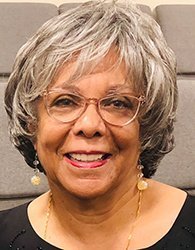
Maurine McDaniel, BFA ’69, MFA ’75, is an associate professor in Spelman College’s Department of Art and Visual Culture in Atlanta, Georgia.
When I transferred, I had been a studio major, and I was very interested in painting, but OHIO had a very strong ceramics department. It had an international reputation. In the meantime, while I was taking the ceramics courses, I became very interested in art history. I really wanted to switch over to art history, but it was a little too late to switch areas of interest, so I stayed with the studio art. But my love for art history really continued, and, as a result, I taught the first African-American art course at OHIO while I was there as a graduate student, and I went on to teach that course in Chicago, where I taught at the Art Institute of Chicago.
I also taught at Loyola University and Roosevelt University. Those were like my bread-and-butter courses; there wasn’t a huge demand for ceramic teachers. At that point in my life, I wasn’t really willing to give myself over to that totally and not know that I was going to be able to make a living. Because there was a demand for art history instructors, I was able to kind of cobble together a whole series of courses at all of these different schools to make a living. I worked for a publisher in the educational division, and then the spot opened up at Spelman. I taught studio and art history for several years, and then, as I began my formal PhD work in art history, I gave up the studio courses and started focusing solely on art history.
What was it like to be a student on campus in the late 1960s?
I was a transfer student, so I came to Ohio University during my junior year. I was at Spelman College initially in Atlanta, Georgia. That’s where I spent my first two years, so it was kind of a culture shock in a way when I transferred because the campus was so large, there were so many students and to go from an African-American women’s college to Ohio University was a huge shift for me. I was able to make the transition very smoothly because I made friends. In 1968, I joined Alpha Kappa Alpha sorority and was able to form a very strong bond with others that I still enjoy today.
It was a very interesting time because we were involved in not only issues of race, but there were feminist issues as well. Being an African-American student, the racial issues were really the ones that dominated. I can remember some sit-ins and some protests about what was being offered in terms of the curriculum. There weren’t any African-American Studies courses. There were some questions with the student body as of why more students of color weren’t being admitted to the college. Those were the types of issues that we were dealing with then.
How do you stay connected to the University?
My sorority Alpha Kappa Alpha, in terms of my class and the groups that surrounded us, has remained very close over the years. We go on a vacation trip with each other every other year. We choose a location; we’ve been to cities like Atlanta or on cruises. This year we are going on a cruise around the Florida Keys together, so this is how we keep the bond strong. Usually there are about 20-25 members who go on these trips. We are able to keep in communication with each other and bond every other year.
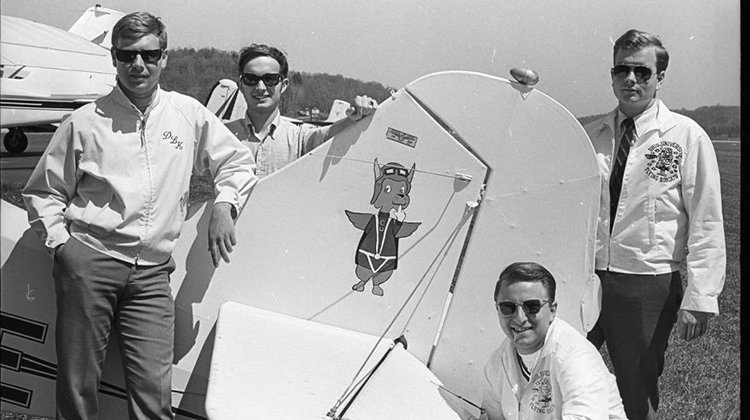
Members of the Flying Bobcats, including (back, right) Terry Timmester, BSJ ’69, pose for a photo with a new airplane in 1969. Photo courtesy Mahn Center for Archives and Special Collections
Terry Timmester, BSJ ’69, Journalism
Terry Timmester came to Ohio University to study journalism, but the Flying Bobcats, a student aviation organization on campus, piqued his interest and led him to a nearly 23-year career as a naval flight officer in the U.S. Navy. Today, Timmester is retired and residing in South Carolina.
What do you remember the campus being like in 1969?
I don’t really have a whole lot of recollection about the protests that were going on in that general timeframe. I tended to avoid those kinds of things.
At that time, the river still flowed through the campus, and I know that there was the changing of the course of the river. Before that, we had significant campus flooding. I can remember that when I lived on the East Green they put out desks for bridges to cross from one building to another because the roads were so flooded. I haven’t been through Athens in 15 years. We used to drive through Athens quite often when I lived in D.C. We would go back to Cincinnati and visit family.
What made you want to join the Flying Bobcats?
I always liked to fly. As a kid, I always wanted to head over to the airport in Cincinnati. I always loved airplanes and flying. I went to Ohio University to be a journalism major. Once I got there, I discovered that they had a flying club. I just started going to the meetings and becoming as active as I could [in the club], and by my sophomore year, I had scraped together enough money to get my private pilot course through the University. That was the kind of start of it. I became quite active in the club and participated in virtually every activity. My junior year I was the treasurer of the club, and my senior year I was president of the club. I went to all of the air meets through my junior year, and then my senior year I had “turned pro” and actually became a flight instructor at the University’s airport, so I couldn’t compete.
Tell me about your life post-graduation.
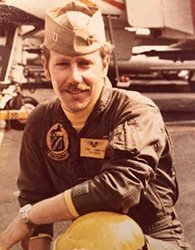
Terry Timmester, BSJ ’69, spent nearly 23 years serving his country as a naval flight officer in the U.S. Navy.
I didn’t end up doing anything with my degree. It essentially got me in the door to fly for the Navy. My draft number wasn’t very high, but it wasn’t very low. It was kind of in between, so I didn’t know if I was going to be drafted into the Vietnam War or not, so I was looking for ways to do something that I would prefer to do. So, I was looking into the Navy to see if I could fly for the Navy. Once I graduated, less than a month later, they flew me out to Washington and swore me into the Navy. I was in the Navy just under 23 years. …
By the time I went into the Navy I had probably 450-500 flight time hours as a pilot. That certainly gave me a leg-up on everyone that didn’t have any flight experience. I had situational awareness and knew what I was doing. To get in, you have to pass an aviation adaptability test, so the Flying Bobcats definitely helped with that.
Tell me about some of your accomplishments as a member of the Flying Bobcats.
In 1968, Ohio University hosted the National Intercollegiate Flying Association’s Safety and Flight Evaluation Conference. Because we were the host school, our board of directors, the Ohio University Flying Bobcats Board of Directors, by default became the board for that year’s National Intercollegiate Flying Association. We had dual hats: I was the treasurer of the University’s club and then I was also treasurer for NIFA for that year.
That year I won the top male pilot award in the spring of 1968. I won a couple other awards for individual events; I can remember finishing in the top three of the power-on landing event. They had both power-on and power-off landing events. The year I won I think I won the power-on and placed high in the power-off landing event. That was pretty much what got me the award. They based it on the various points you received from the competition. …
I came back to a Flying Bobcats Reunion that they had while I was still in the Navy. It was sometime in the early ’90s. One of the guys in the Flying Bobcats with me that I was relatively close to became a Blue Angel during his time in the Navy. After that reunion, I began to lose touch. I spent most of my career out on the West Coast and that made it tough. I also spent some time in Germany. Of course, this was long before the days of email, so it was either you’d pick up the phone and call or sit down and write a letter.
What was your favorite memory from your OHIO experience?
I think just the camaraderie that I had with the aviation community. It’s really a pretty close-knit group. I was probably as close to them as you would be in a fraternity or any other organization. The friendships I developed were amazing. I loved Ohio University in general, but I think that the Flying Bobcats is what I remembered the most.
***
We want to hear from this year’s Golden Bobcats! What are your favorite OHIO memories? Share your stories in the comments below.
Disclaimer: It is not the intent of Ohio University to imply an endorsement by any service branch of the U.S. Armed Forces.
